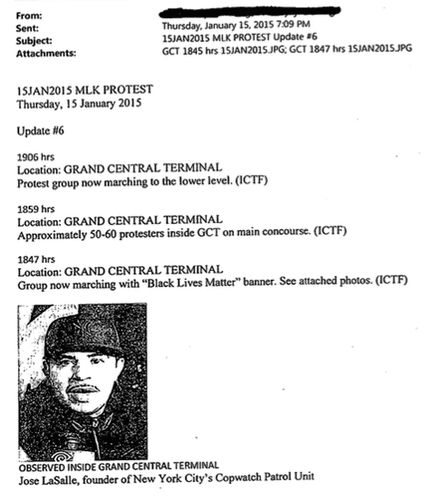Legal papers filed by the New York police department reveal that the department sent its own undercover officers to protests led by Black Lives Matter after the death of Eric Garner. The NYPD documents also show that it collected multimedia records about the protests.
The NYPD disclosed its undercover operations in response to a group of New York attorneys requesting records under the state freedom of information law. The department has thus far declined to provide the records requested. But its descriptions in August court filings of the records it is refusing to release provide new details about its monitoring of protests at Grand Central Station:
- The first set contains “multimedia records” relating to the petitioners’ request for “pictures, videos, audio recordings, data, and metadata” collected or received by the NYPD at the Grand Central Station protests, which Black Lives Matter groups are still leading, according to the NYPD response.
- The second “consists entirely of communications between and among NYPD undercover officers and their handlers”, pertaining to the protests. According to a 22 August NYPD Memorandum of Law, these undercover communications “consist primarily of immediate impressions concerning ongoing events”.
- The third “consists of a single record, which is a communication from an NYPD officer working in an undercover capacity and his base”, pertaining to the protests, the response indicates.

The revelations come from the same records request that led to the Intercept’s release of documents last summer showing that MTA and Metro-North transit police had regularly spied on Black Lives Matter protesters in and around Grand Central, deploying plainclothes officers to monitor demonstrations, track their movements, and share photos of activists. Though some NYPD officials appeared to be linked to the monitoring, those documents did not confirm whether the NYPD itself was leading its own surveillance operation targeting activists.
The attorneys litigating for the records say the NYPD’s newly revealed operations are potential constitutional violations, especially since released MTA and Metro-North police observations of these protests frequently stated that the gatherings were “peaceful” and “orderly”.
“The fear and disarming effect caused by undercovers being assigned to what were and continue to be extraordinarily peaceful protests is disturbing,” said MJ Williams, one of the attorneys involved in the records request. “To the extent that it would influence individuals not to participate and get individuals to censor what they say because of a fear of undercovers – that’s a basis for a first amendment violation.”
She added: “As someone who was present at the protests, it’s disturbing to know the NYPD may have a file on me, ready to be used or to prevent me from getting a job simply because I’ve been active in some political capacity. That’s potentially a fourth amendment violation for unlawful seizure, but on the other hand, we’ve seen law enforcement agencies have all sorts of justifications for data collection for public safety that the courts have allowed.”
In response to the Freedom of Information Law request, John Donohue, the second highest ranking uniformed officer in the NYPD’s intelligence bureau, argued in an affidavit that the NYPD could not release the records because public understanding of the undercover operations could help “would-be criminals” learn “the circumstances in which the NYPD does not, or cannot, deploy undercover officers”. The release of the “multimedia” records of the protests, Donohue said, also could reveal “the kinds of optical technology NYPD uses, both in its undercover and general surveillance operations” and “any areas NYPD does not have under surveillance, thereby exposing gaps in coverage”.
The MTA and Metro-North disclosures from last summer revealed that transit police tracked activists’ locations and shared images of some activists, like Jose La Salle, an organizer with the New York police watchdog group Copwatch Patrol Unit, and Alex Seel, a movement photographer.
If similar multimedia images are being held by the NYPD, they could be a violation of the NYPD’s protest monitoring rules, known as the Handschu guidelines, which are supposed to prevent the department from deploying undercovers or collecting images of protesters solely to keep tabs on their political activity.
Martin Stolar, an attorney who helped bring about the Handschu guidelines in 1971, said it isn’t clear if the NYPD violated the guidelines since we do not know if the monitoring is part of an authorized ongoing investigation. In an email to the Guardian, Stolar explained, the NYPD is “unlikely to tell you, or anyone, whether an investigation is ongoing or not and authorized or not”.
The NYPD did not respond to a request for comment.
In recent years the NYPD has been criticized for alleged spying on political and ethnic groups without substantial evidence of criminal activity. New York City’s independent police monitor released a report in August, concluding that between 2010 and 2015 the department routinely violated legal requirements in its monitoring of Muslim communities, failing to explain its use of undercovers and informants and extending investigations without evidence of criminal activity.
In recent weeks, Black Lives Matter activists in New York have pointed to apparent sightings of undercover NYPD officers at protests and claim that the surveillance is ongoing.
“This is still happening, we still have undercovers at our protests weekly,” said Armie Jeffreys, an organizer with NYC Shut It Down and Millions March. “But we’re still out here. They can try if they want to, but it’s not gonna stop us.”

Comments (…)
Sign in or create your Guardian account to join the discussion